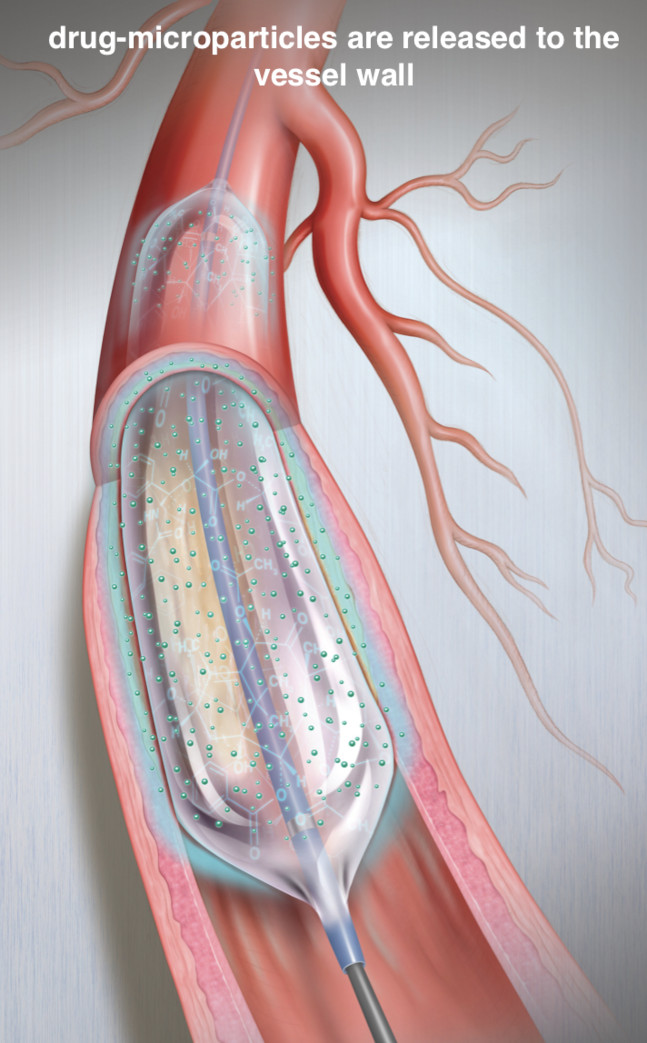Drug-coated balloon
What is a drug-coated balloon?
The drug-coated balloon is a new device for the treatment of patients with coronary atherosclerotic disease to be used during angioplasty.
In recent years, coronary interventions benefited from the introduction of balloons able to release sirolimus or similar drugs to the wall of the artery.
A drug-coated balloon:
Is a balloon able to rapidly and homogeneously transfer an antiproliferative drug to the vessel wall;
Unlike drug-eluting stents, drug-coated balloons do not leave any permanent foreign body inside the artery.
The use of these devices became routine in the treatment of restenosis which may develop following implantation of a metal stent. Recently, drug-coated balloons are utilized to deliver the antiproliferative medications, instead of stents, when the result after the initial dilation of the narrowing is judged to be optimal.
The following image (Image A) shows the Left Anterior Interventricular artery with stenosis at the bifurcation with diagonal branch and distal diffuse disease.
Traditional solution: implantation of long drug eluting metal stents to cover the stenotic artery.
"Metal free" solution: implantation of a short bioabsorbable scaffold at the bifurcation level and the rest of the artery is treated with a drug-coated balloon.
Following optimal predilation, a 24 mm long bioresorbable scaffold is implanted (Image B) and long drug-coated balloon to treat the distal diffuse disease (Image C). It is possible to utilize a hybrid solution with a short metal drug-eluting stent instead of the bioresorbable scaffold. Both approaches will eliminate or limit the amount of foreign body permanently inserted.
Image D shows the final result.
Studies
Historically, drug-coated balloons have been used to treat intra-stent restenosis. Regarding the treatment of stenosis, which did not occur inside a stent, initial studies showed discordant results. Problems were related to:
Incomplete dilatation of the artery before implementing the usage of a drug-coated balloon;
Usage of some drug-coated balloon with unpredictable drug release pattern.
The most recent studies, with modern devices, are showing positve data, especially for patients in whom the use of the drug eluting stent is not recommended due to the anatomical characteristics of the stenosis to be treated (long lesions, small vessels). A hybrid approach has recently been proposed: drug eluting stents and drug-coated balloons.
What are the advantages of drug-coated balloons over metal stents, including bioresorbable scaffolds?
The latest generation of drug-coated balloons:
Can transfer to the wall of the coronary artery adequate amounts of antiproliferative medication;
No foreign body is left behind.
Regarding the absence of a foreign body, it should be emphasized that there is an advantage compared to bioresorbable scaffolds. Bioresorbable scaffolds are foreign bodies for the first 1-2 years after implantation requiring antiplatelet therapy.
What are the unique features of drug-coated balloons?
Thanks to the absence of a foreign bodies, the usage of drug-coated balloons require treatment with dual antiplatelet therapy (aspirin and another medication) for a shorter time duration compared to the needs following implantation of a drug-eluting stent or a bioresorbable scaffold.
Why we chose the Selution Drug-Coated Balloon
The Selution, Sirolimus Drug-Coated Balloon (MedAlliance, Nyon, Switzerland), uses a technology allowing the drug to remain in the vessel wall for a similar period to the one of limus released by drug eluting stents. A period of at least three months is very important to obtain the antiproliferative effect needed to prevent restenosis. The graph below illustrates the results of experimental studies documenting the prolonged stay in the artery wall of sirolimus released by the Selution balloon.







